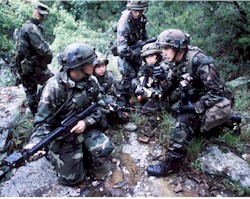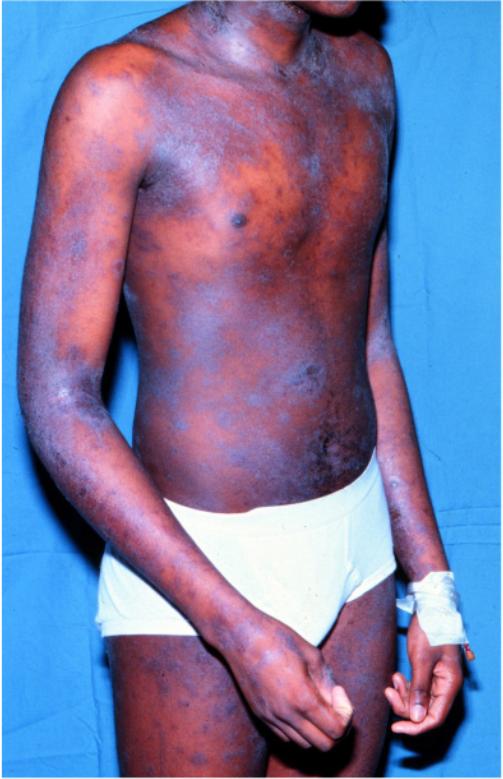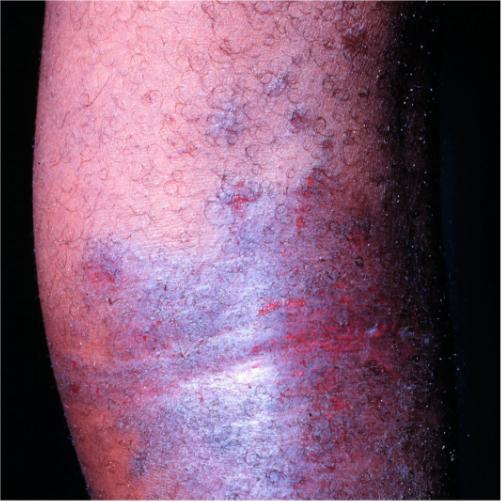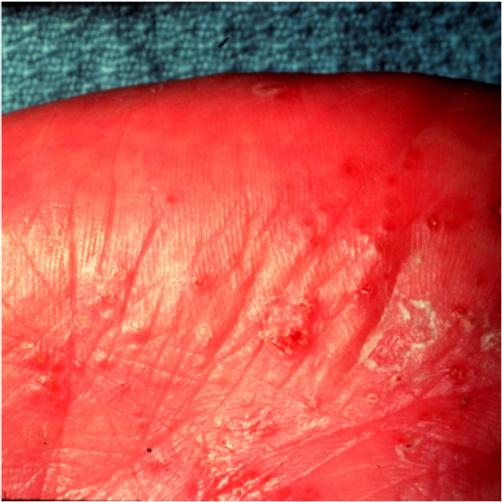Eczema and Contact Dermatitis
|
(a) Administrative Notes Hand eczema (endogenous and exogenous), atopic dermatitis, and other forms of eczema are the second most costly form of dermatologic, occupationally aggravated, or induced "illness" in the civilian world and DoD. In particular, endogenous hand eczema and atopic dermatitis are notoriously unpredictable. For this and other reasons these conditions are disqualifying for entry into the United States Armed Forces. If present in a currently serving member, these conditions are considered to be disqualifying for aviation, submarine, and Special Forces duty as well as other specialized military duty. Why is this so? The actuarial data of many decades gives us the answer. Even if a patient's eczema has been minimally active (or even totally quiescent) this is not an accurate predictor of future severity. Military dermatologists (like our civilian occupational dermatology colleagues) routinely encounter many patients whose "minimal" eczema ultimately flared badly in the military or special occupational environment. Figures 4 and 5 illustrate such a case of Atopic Dermatitis in a Navy Mess Management Specialist. His eczema flared very badly during Operation Desert Shield/Storm, ultimately impetiginized and was the source of an outbreak of Staph food poisoning. Figure 6 illustrates a case of a man with known Dyshidrotic Eczema of the hands who was granted a medical waiver for enlistment. His hands flared very badly during his training as a jet engine mechanic. He was ultimately medically separated from the Navy. This group of skin diseases causes a great deal of morbidity, lost productivity and administrative burden to the military. Waivers for entry in a patient with known endogenous eczema or hand dermatitis should be rarely granted, only after thoughtful deliberation. Please remember this fact if you are doing entry physicals or special duty qualification exams.
(b)
Treatment The treatment of eczema can be likened to be a three legged footstool. If you remove one or more of the legs, the footstool will not stand. The same is true for eczema therapy. The three legs of this therapeutic footstool are lubrication, medication, and control of the skin's environment.
Lubrication of dry eczematous dermatitis can be
done with a wide variety of emollients, the simpler the better.
Frequent use of bland products such as Eucerin, Aquaphor, or Vaseline
is preferable to the more expensive fragrance containing and
chemically complex products. Fragranced products, while "elegant",
are potential irritants and/or allergens and should be avoided on
irritated skin of any kind, but especially in patients with eczema.
The medication leg of the footstool usually
involves topical steroids. The advice here is similar; keep it
simple. Topical steroids are available in a variety of potencies and
vehicles. In general, do not use medium potency or higher products on
the face or genitals. Gels or aerosolized steroid sprays are
appropriate for moist and weepy dermatitis. Creams and ointments are
effective on drier more chronic lesions. While topical steroid
"allergies" do occur, the reactions to topical steroid medications
more likely represent a sensitivity to a preservative, fragrance, or
other ingredient in the vehicle.
Medication of acute or "wet" eczema (e.g. poison
ivy or flare of atopic or dyshidrotic eczema of the hands) has
additional considerations. Burow's Solution compresses (see Impetigo)
can dry out a wet oozing eczema within a few days. Decrease the
bacterial colonization of the eczema with a few days of
antistaphyloccal antibiotic therapy.
Systemic steroids are reserved for cases of
substantial morbidity or widespread involvement. If required, use 1
mg/kg of prednisone in a tapering dose over a 2-3 week period while
initiating topical therapy. Shorter courses or lower doses frequently
result in "rebound" of the dermatitis. Otherwise healthy active duty
personnel tolerate brief courses of prednisone very well. If a
patient has reached this point of severity, dermatology consult is
highly advised.
The last leg of the footstool is environmental
control. This simply means to decrease the skin's exposure to any
identified offending substance, harsh bath soaps, occupationally
related chemicals and the like.
Most cases of hand eczema are irritant or
endogenous (i.e. a form of atopic dermatitis) rather than allergic.
The proper use of protective gear (e.g. work gloves), minimizing
repeated wet/dry exposures of the involved area etc will allow the
skin to heal faster. Here is a diagnostic "pearl" concerning eczematous dermatitis on the foot. If vesicles are present, especially on the plantar surface, do a KOH (potassium hydroxide) prep on the roof of a vesicle. If positive, the therapeutic strategy involves antifungal therapy. Eczematous dermatitis exclusively on the dorsum of the foot is usually not fungal. |
Written and revised by CAPT Dennis A. Vidmar, MC, USN, Department of Military and Emergency Medicine, and Department of Dermatology, Uniformed Services University of the Health Sciences, Bethesda, MD (1999). Additional images provided by CAPT Vidmar in June, 2000, subsequent to the initial publication of this manual.
|
Preface · Administrative Section · Clinical Section
The
General Medical Officer Manual , NAVMEDPUB 5134, January 1, 2000
Bureau
of Medicine and Surgery, Department of the Navy, 2300 E Street NW, Washington, D.C.,
20372-5300
This web version of The General Medical Officer Manual, NAVMEDPUB 5134 is provided by The Brookside Associates Medical Education Division. It contains original contents from the official US Navy version, but has been reformatted for web access and includes advertising and links that were not present in the original version. This web version has not been approved by the Department of the Navy or the Department of Defense. The presence of any advertising on these pages does not constitute an endorsement of that product or service by either the Department of Defense or the Brookside Associates. The Brookside Associates is a private organization, not affiliated with the United States Department of Defense. All material in this version is unclassified. This formatting © 2006 Medical Education Division, Brookside Associates, Ltd. All rights reserved.
Home · Textbooks and Manuals · Videos · Lectures · Distance Learning · Training · Operational Safety · Search
|
|
|
This website is dedicated to the development and dissemination of medical information that may be useful to those who practice Operational Medicine. This website is privately-held and not connected to any governmental agency. The views expressed here are those of the authors, and unless otherwise noted, do not necessarily reflect the views of
the Brookside Associates, Ltd., any governmental or private organizations. All writings, discussions, and publications on this website are unclassified.
© 2006 Medical Education Division, Brookside Associates, Ltd. All rights reserved
Other Brookside Products



